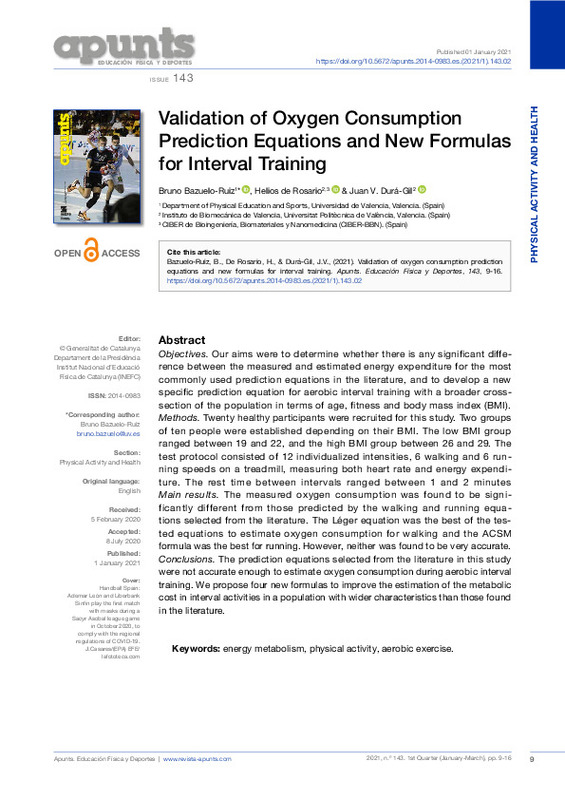JavaScript is disabled for your browser. Some features of this site may not work without it.
Buscar en RiuNet
Listar
Mi cuenta
Estadísticas
Ayuda RiuNet
Admin. UPV
Validation of Oxygen Consumption Prediction Equations and New Formulas for Interval Training
Mostrar el registro sencillo del ítem
Ficheros en el ítem
| dc.contributor.author | Bazuelo-Ruiz, Bruno
|
es_ES |
| dc.contributor.author | De Rosario Martínez, Helios
|
es_ES |
| dc.contributor.author | DURÁ-GIL, JUAN V.
|
es_ES |
| dc.date.accessioned | 2022-11-14T19:02:19Z | |
| dc.date.available | 2022-11-14T19:02:19Z | |
| dc.date.issued | 2021-03 | es_ES |
| dc.identifier.uri | http://hdl.handle.net/10251/189733 | |
| dc.description.abstract | [EN] Objectives. Our aims were to determine whether there is any significant difference between the measured and estimated energy expenditure for the most commonly used prediction equations in the literature, and to develop a new specific prediction equation for aerobic interval training with a broader cross-section of the population in terms of age, fitness and body mass index (BMI). Methods. Twenty healthy participants were recruited for this study. Two groups of ten people were established depending on their BMI. The low BMI group ranged between 19 and 22, and the high BMI group between 26 and 29. The test protocol consisted of 12 individualized intensities, 6 walking and 6 running speeds on a treadmill, measuring both heart rate and energy expenditure. The rest time between intervals ranged between 1 and 2 minutes Main results. The measured oxygen consumption was found to be significantly different from those predicted by the walking and running equations selected from the literature. The Leger equation was the best of the tested equations to estimate oxygen consumption for walking and the ACSM formula was the best for running. However, neither was found to be very accurate. Conclusions. The prediction equations selected from the literature in this study were not accurate enough to estimate oxygen consumption during aerobic interval training. We propose four new formulas to improve the estimation of the metabolic cost in interval activities in a population with wider characteristics than those found in the literature. | es_ES |
| dc.description.abstract | [ES] Objetivos. Nuestro objetivo era determinar si existe alguna diferencia significativa entre el gasto energético calculado y previsto en las ecuaciones predictivas de uso más frecuente en la literatura, así como desarrollar una nueva ecuación predictiva específica para el entrenamiento interválico aeróbico con una muestra más transversal de la población en términos de edad, forma física e índice de masa corporal (IMC). Métodos. Se reclutó a veinte participantes sanos para el estudio. Se establecieron dos grupos de personas, en función de su IMC. El grupo con un IMC bajo tenía un IMC de entre 19 y 22 y el grupo con un IMC alto, uno de entre 26 y 29. El protocolo de las pruebas consistía en realizar 12 rutinas de intensidades individualizadas, 6 velocidades andando y 6 corriendo en cinta, y medir tanto la frecuencia cardíaca como el gasto energético. El tiempo de reposo entre intervalos varió de 1 a 2 minutos. Resultados principales. Se detectó que el consumo de oxígeno medido era significativamente distinto del predicho por las ecuaciones relativas tanto al ejercicio de andar como de correr seleccionadas entre la literatura. De entre las comprobadas, la ecuación de Léger fue la que arrojó mejores resultados para calcular el consumo de oxígeno al andar y la fórmula ACSM demostró ser la mejor para correr. Sin embargo, se comprobó que ninguna de las dos ofrecía una alta precisión. Conclusiones. Las ecuaciones predictivas seleccionadas de la literatura para este estudio no demostraron ser lo bastante precisas para calcular el consumo de oxígeno durante el entrenamiento interválico aeróbico. En este trabajo se proponen cuatro fórmulas nuevas para mejorar el cálculo del gasto metabólico en actividades interválicas en una población con características más amplias que las encontradas en la literatura. | es_ES |
| dc.language | Inglés | es_ES |
| dc.publisher | Institut Nacional d'Educació Física de Catalunya | es_ES |
| dc.relation.ispartof | Apunts. Educación física y deportes (Online) | es_ES |
| dc.rights | Reconocimiento - No comercial - Sin obra derivada (by-nc-nd) | es_ES |
| dc.subject | Energy metabolism | es_ES |
| dc.subject | Physical activity | es_ES |
| dc.subject | Aerobic exercise | es_ES |
| dc.subject | Actividad física | es_ES |
| dc.subject | Ejercicio aeróbico | es_ES |
| dc.subject | Metabolismo energético | es_ES |
| dc.title | Validation of Oxygen Consumption Prediction Equations and New Formulas for Interval Training | es_ES |
| dc.title.alternative | Validación de las ecuaciones predictivas del consumo de oxígeno y nuevas fórmulas para el entrenamiento interválico | es_ES |
| dc.type | Artículo | es_ES |
| dc.identifier.doi | 10.5672/apunts.2014-0983.es.(2021/1).143.02 | es_ES |
| dc.rights.accessRights | Abierto | es_ES |
| dc.contributor.affiliation | Universitat Politècnica de València. Instituto Universitario Mixto de Biomecánica de Valencia - Institut Universitari Mixt de Biomecànica de València | es_ES |
| dc.description.bibliographicCitation | Bazuelo-Ruiz, B.; De Rosario Martínez, H.; Durá-Gil, JV. (2021). Validation of Oxygen Consumption Prediction Equations and New Formulas for Interval Training. Apunts. Educación física y deportes (Online). (143):9-16. https://doi.org/10.5672/apunts.2014-0983.es.(2021/1).143.02 | es_ES |
| dc.description.accrualMethod | S | es_ES |
| dc.relation.publisherversion | https://doi.org/10.5672/apunts.2014-0983.es.(2021/1).143.02 | es_ES |
| dc.description.upvformatpinicio | 9 | es_ES |
| dc.description.upvformatpfin | 16 | es_ES |
| dc.type.version | info:eu-repo/semantics/publishedVersion | es_ES |
| dc.description.issue | 143 | es_ES |
| dc.identifier.eissn | 2014-0983 | es_ES |
| dc.relation.pasarela | S\452029 | es_ES |








